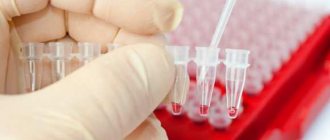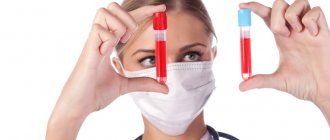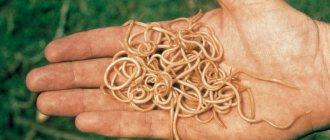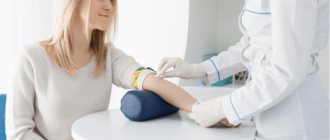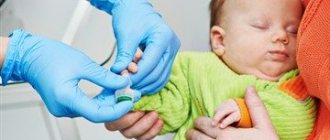When and how the analysis is done
In order to determine the level of yellow pigment and other elements, blood is taken from the umbilical cord immediately after the baby is born.
Of 100 percent of total bilirubin, direct should not exceed 25 percent, and indirect - 75. The next analysis is done three days later. Reasons for concern:
- Bilirubin is above 256 µmol/liter in full-term infants.
- Indicators exceed 172 µmol/liter in premature infants.
https://youtube.com/watch?v=-XWIaMSSbIE
The causes of physiological jaundice are:
- premature birth;
- pathological course of pregnancy;
- maternal diabetes;
- fetal hypoxia in the womb;
- asphyxia of the newborn during childbirth.
This type of jaundice can appear even a week after the baby is born, when he begins to receive full breast milk. This is due to the fact that, along with mother’s milk, the baby receives a large amount of the hormone estrogen, and it suppresses the breakdown of bilirubin and its excretion from the body. Treatment for physiological jaundice is not required; it goes away on its own after a few days.
Pathological jaundice poses a great danger. Its causes may be an Rh conflict in a pregnant woman during pregnancy or incompatibility in the blood type of mother and child.
In addition, this pathology is provoked by:
- liver failure in an infant;
- prematurity of the child;
- pinpoint hemorrhages;
- intestinal obstruction;
- infectious liver diseases;
- use of hormonal stimulating drugs during prolonged labor;
- genetic predisposition.
What is dangerous about pathologically high bilirubin in a baby, what threatens it? The fact is that this pigment is capable of destroying nerve cells. If there is little of it, it simply does not reach them, because it is excreted along with urine and feces. But if it accumulates in the baby’s body, there is a high risk of it penetrating the nerve cells. And this can have the most unpredictable and irreversible consequences for its development.
That is why, immediately after birth, a blood test is required to determine total, soluble and insoluble bilirubin in the newborn, and after some time it is repeated. A young mother should not interfere with such research. And if the results show increased bilirubin, do not panic, but carefully monitor your child’s condition.
If the baby is relatively calm, takes the breast, responds to all the required reflexes, and other indicators are normal, there is no reason for concern. After a few days the indicators return to normal. But otherwise, the baby will need emergency medical help: if the newborn’s bilirubin is elevated, neither he nor his mother will leave the maternity hospital until its concentration stabilizes.
How is a bilirubin test done in infants?
Bilirubin is measured by taking blood from the umbilical cord, then a blood test is taken 2 days later. For premature babies, this procedure is repeated every day for a week. In children without pronounced signs of jaundice, the level of bilirubin is determined by a special device - a digital bilirubinometer. The procedure is painless, measurements are taken in the area of the forehead, chest and bridge of the nose.
The second way to determine how much bilirubin a baby has is a blood test. It is taken from the heel of a newborn with a special needle and should be taken on an empty stomach. A month later, the study is done again, blood is taken from a vein - this is a common practice for newborn children.
Bilirubin levels are determined from a newborn blood test
If the indicators are consistently elevated, the baby will be left for treatment in a hospital, because he requires observation and therapy until complete recovery, that is, the pigment content in the blood decreases to a normal level. The doctor at the hospital will order additional tests:
- general blood analysis;
- analysis for total, direct and indirect bilirubin;
- Coombs test (for hemolysis);
- a comprehensive blood test for liver and biliary tract diseases;
- Ultrasound of the abdominal organs;
- consultations with other specialists.
If, while already at home, parents discover disturbing symptoms, they should contact their pediatrician and get tested again. This is necessary when detecting:
- drowsiness;
- severe anxiety;
- tachycardia;
- enlarged liver and spleen (we recommend reading: what does an enlarged liver mean in a child according to ultrasound?);
- the appearance of seizures;
- maintaining jaundice.
Bilirubin standards for infants
The levels of this pigment in the blood plasma of a baby are off the charts - they are never so high in the life of a healthy person.
Immediately after birth, a concentration of no more than 60 µmol/liter of bilirubin in the blood is considered normal. After a couple of days, the concentration increases significantly; it can be 200 µmol/liter. This is also not a reason to panic, this phenomenon is completely normal. Norms change over time:
- A month later, the pigment level is completely different - a one-month-old baby has bilirubin from 8.5 to 20.5 µmol/liter.
- It is noteworthy that premature babies will have less of this substance in their blood. The permissible concentration for such babies is about 170 µmol/liter.
How to explain such large fluctuations in such a short period of time?
The answer is simple: in a newborn, the enzyme system is not yet fully functional, although it is fully formed, so bilirubin is excreted from the body very slowly. In the mother's womb, the baby did not breathe on its own; it received oxygen from her blood. More precisely, from red blood cells that are saturated with fetal or fetal hemoglobin.
When a child is born and begins to breathe on his own, this hemoglobin is no longer needed, it begins to actively break down - bilirubin is released. That is why its indicators are so high in the first days of the baby’s life.
So, the norms of bilirubin in the blood of infants differ significantly from similar indicators in adults, which is necessarily taken into account by the doctor when deciphering the results.
Signs
What symptoms indicate increased bile pigment in a child?
- yellowness of the skin and sclera of the eyes;
- weakness and lethargy;
- weak sucking reflex;
- darker urine color;
- stool discoloration;
- enlarged liver and spleen;
- poor general blood test.
All these symptoms indicate a pathological process in the body associated with an increase in the level of yellow pigment, and therefore require urgent diagnosis and treatment. As a diagnosis, a biochemical blood test is performed - a laboratory technician identifies the exact figures for the level of bilirubin in the plasma. Based on the test results, the doctor selects treatment.
Trying to reduce the level of yellow pigment yourself at high values is not worth it! After all, this can lead to serious consequences, because it has been proven that with its high content it causes mental retardation and also has a negative effect on the nervous system.
Other reasons
Hyperbilirubinemia in newborns can be observed against the background of obstructive jaundice. It occurs when the bile ducts are blocked by something. Most often these are stone obstructions or wall stenosis. In this case, the symptoms are similar to an infectious liver lesion. Certain instrumental diagnostics are required before prescribing treatment.
Another cause of increased bilirubin can be considered cirrhosis of the liver. This is an extremely rare phenomenon when it comes to children's audiences. However, its course is more malignant than in adults. The cause of increased concentration may also be intestinal obstruction. Children often encounter this problem, according to statistics - three percent. The main symptom of this problem is pain. The child presses his legs to his stomach and cries incessantly. At an early stage, obstruction is often confused with banal colic, but later the picture becomes clearer.
We are talking about the presence of alternating constipation and diarrhea, against the background of which persistent constipation subsequently forms. There is bloating, flatulence, and the patient is unable to pass gases normally. Advanced cases are marked by vomiting of blood and fecal impurities. This pathology also has a chronic form. In this case, it is perceived as normal constipation.
Diseases that are influenced by hormonal levels cannot be ruled out. This includes insufficiency of the pituitary gland and diabetes mellitus. At an early age it is very difficult to determine a specific hormonal disease. Sometimes newborns experience internal bleeding, which can vary in intensity. Autoimmune processes cannot be ruled out, against the background of which the destruction of red blood cells occurs.
To assess the level of bilirubin, blood is used and sent for a special analysis. Sample collection requires prior fasting. We are talking about about four hours, and not about eight, as with adults. Typically, the baby's heel and a special small vacuum tube are used for collection.
To fully analyze the situation, it is recommended to determine bilirubin by fractions. This will help in establishing not only the type of jaundice, but also the reason for its transition to a pathological form. Treatment of elevated bilirubin is required, since its high concentration negatively affects the child’s health.
Elevated bilirubin is dangerous for the human brain and nervous system. The problem is that the pigment can accumulate, leading to severe body intoxication. The consequence is the death of brain cells and nerve endings. The consequences of such bilirubin work can be deterioration of hearing and vision, mental disorders, dementia and other problems.
Bilirubin levels in newborns
Unlike adults, elevated bilirubin in newborns is a common occurrence. This happens due to the destruction of fetal hemoglobin, which is somewhat different in structure from the hemoglobin that is formed after birth. Thus, fetal hemoglobin is actively destroyed, increasing bilirubin levels. But even severe physiological jaundice in most cases goes away on its own. In some cases, phototherapy is prescribed.
If the baby was born prematurely, one of the reasons for high bilirubin levels may be an underdeveloped liver. Jaundice and increased bilirubin levels are an almost inevitable price to pay for being born too early.
Elevated bilirubin levels in newborns, the norm on days 3-4 after birth is 256 µmol/l for full-term infants, 171 µmol/l for premature infants, requires close medical supervision. It may indicate the same disorders that can be suspected with elevated bilirubin levels in adults. In the case of newborns, treatment must be started even faster, since the risk of developing a life-threatening condition and complications is very high.
In addition to common diseases that increase bilirubin levels, newborns can develop hemolytic disease of the newborn. It is caused by incompatibility of the child and mother for Rh and antigens. In this case, the rate of destruction of red blood cells greatly increases, and accordingly, the level of bilirubin increases.
Normal indicators in newborns
What is the normal level of bilirubin in the blood of newly born babies? Why is it necessary to know and control this indicator and why is its increase dangerous? Initially, it should be noted that the coefficient of yellow pigment content in infants is a rather individual value, but there is a special table in which it is indicated by day of the child’s life.
As mentioned above, direct bilirubin is a dangerous toxin. A significant increase in this indicator can cause the development of serious disorders of the nervous system, digestive tract and can lead to death.
With a non-pathological increase in bilirubin, that is, with physiological jaundice of newborns, due to the destruction of a large number of red blood cells, the liver simply does not have time to bind all the released pigment. As a result, it accumulates in the subcutaneous fat, thereby leading to yellowing of the baby’s skin and sclera.
The height of this condition is observed on the 4th – 8th day of the baby’s life. In this case, the laboratory indicator increases already on the second day after birth. By the fourth day, it can reach 220 µmol/l in full-term babies and 170 µmol/l in babies born earlier than their due date. Moreover, the critical level of content for the former is considered to be 320 µmol/l, and for the latter – 150–220.
What happens in the baby's body
The fact that a few days after being outside the womb, bilirubin in newborns begins to increase is explained by the physiological peculiarity of the restructuring of the body. This period is characterized by the following processes:
- as there is no need for a large amount of hemoglobin, it begins the process of decay;
- when deformed, red cells release bilirubin - a special pigment that participated in the formation of iron-containing protein - hemoglobin and is released into the blood in an abnormally large volume;
- the accumulation of bile pigment in the bloodstream increases;
- the dermis and sclera are painted in the tone of the pigment - yellow-mustard.
At the beginning of life outside the womb, the baby’s liver is simply not able to cope with high bilirubin levels, since its functionality is not yet fully developed. This condition is considered transient (transitional, temporary), and corresponds to the norms of physiological development of the child. This type of jaundice is called physiological and does not require special treatment.
So does breastfeeding jaundice. After childbirth, the concentration in milk of hormones that reduce the activity of liver enzymes is high, and during natural feeding they penetrate into the baby’s body, causing jaundice. With an increase in the amount of milk in the breast, everything returns to normal and the baby recovers.
Therapy methods to reduce bilirubin levels
Physiological jaundice does not require special treatment - if the coefficient has increased, doctors recommend feeding the baby with breast milk, so he will quickly cope with excess bilirubin in the body. Formula-fed babies need to drink plenty of fluids. For pathological jaundice, a number of procedures are prescribed to reduce the content of toxic pigment in the blood.
Physiological jaundice goes away on its own, provided that the baby’s sleep and nutrition are correct.
Phototherapy (quartz treatment)
The child is placed in a special ditch, wearing safety glasses or covering his face with a diaper and exposed to intense light. Bilirubin accumulated in subcutaneous fat in newborns is destroyed by ultraviolet light. You will have to lie under such a lamp for several hours a day. The baby is taken away only for hygiene procedures and again placed in a ditch.
Drug treatment
The medications are prescribed by the attending physician depending on the baby’s health condition. Usually prescribed:
- enterosorbents (Smecta, Enterosgel) to remove excess bilirubin;
- hepatoprotectors (Silibor, Essentiale) to cleanse toxins and restore liver function;
- droppers to normalize electrolyte levels.
Infusion therapy
Infusion therapy (intravenous glucose) is used in cases where the child does not drink enough fluid.
It is not a direct way to reduce bilirubin levels. Its purpose is to neutralize the toxic effects on the body and remove excess of this pigment.
General information
Before moving on to the direct causes of increased bilirubin in newborns, it is worth briefly telling what it is. When the level of bilirubin in a newborn is measured, we are talking about determining a special pigment in the blood, which is formed against the background of the destruction of protein blood components. In both adults and infants, bilirubin is yellow-brown in color.
The intestines and urinary system are responsible for the removal of pigment. Under the influence of enzymes produced by the liver, bilirubin in a child is excreted along with feces and urine. At the same time, the norms of bilirubin in the blood of newborns demonstrate the fact that the pigment is produced every day, that is, it is present in the body on an ongoing basis. However, this amount should be insignificant
As soon as abnormalities from the norm are detected in a blood test for bilirubin in newborns, it is important to provide assistance, since in high concentrations bilirubin is dangerous due to its toxic effect on the body
Most often, when a bilirubin test is done in newborns or adults, total bilirubin is determined. Already in accordance with the data obtained, you can decide whether it is necessary to check the bilirubin level by fraction.
Total bilirubin is divided into two categories: direct bilirubin and indirect. The indirect form refers to the total fraction that is formed as part of the breakdown of fetal hemoglobin in newborns. Studies have shown that this type of pigment cannot dissolve, so it is impossible to remove it from the body through the gastrointestinal tract or urinary system. In this case, in the body of a newborn, a variant of normal tests will be an indicator when bilirubin is increased simultaneously with hemoglobin.
In order for bilirubin not to accumulate in a two-month-old child and a person of any other age, and for the substance to leave the body, it needs to turn into a direct fraction. The liver, which produces special enzymes, is responsible for this transformation process. Therefore, if analyzes have demonstrated that the level of bilirubin in children of the indirect type is increased, it is urgent to understand why it began to increase and how to lower it as quickly as possible. A common reason why high bilirubin is detected is insufficient liver function.
Low bile pigment levels
Reasons for the decline
Low bilirubin is much less common than high bilirubin. For diagnosing the disease, cases when the coefficient is significantly reduced are important. To date, scientists have not fully studied the mechanisms that lead to a decrease in its concentration. However, the reasons for such indicators of the substance in the blood may be:
- chronic malnutrition;
- low hemoglobin level and low concentration of red blood cells (erythrocytes);
- iron deficiency.
Often, low direct or indirect bilirubin is a violation of the blood test method. The results of the study may be affected by taking certain medications, including antibiotics and ascorbic acid.
Reduced bilirubin levels are diagnosed much less frequently than elevated ones
What does a low concentration in the blood indicate?
If a reduced concentration of pigment is found in the lymph, this means that very little of it is formed during the breakdown of hemoglobin. The condition of the body indicates that the patient has a decreased amount of hemoglobin, and the tissues do not receive enough oxygen. Sometimes the parameter speaks about diseases:
- chronic renal or liver failure;
- aplastic anemia;
- acute leukemia;
- tuberculosis;
- various infectious diseases.
In adults, a reduced amount of the enzyme may be due to stagnation of bile, so its content can be increased with proper nutrition and physical activity. In children, therapy consists of identifying the causes and treating the disease that caused the decrease in the indicator. Folk remedies are used only as auxiliaries, in parallel with the use of medications.
The main reasons for increased pigment in children from 2 months
It is not uncommon for pigment in the blood to increase at two months or older for the following reasons:
disturbances in the synthesis of bilirubin;
bile stagnation;
congestion in the liver;
the presence of malignant or benign tumors of the circulatory system and liver;
vitamin deficiency regarding vitamin B12.
Since by the age of one month the blood picture should be normal, if there is a sharp increase in bilirubin in the blood after this age, it is necessary to urgently examine the baby, since there is a risk that a malignant neoplasm is developing in the liver. However, most often a blood test shows that everything is normal and the problem lies in the mother’s poor nutrition during breastfeeding.
Attention: each child with a similar problem has individual reasons and can only be determined by a doctor.
Prevention
There is no clear method for preventing jaundice in newborns. It can appear in absolutely anyone, even the healthiest baby. We can only give general recommendations:
- a pregnant woman should be observed by a doctor and undergo all scheduled examinations on time;
- preferably natural delivery;
- Breastfeeding is necessary - mother's milk helps eliminate bilirubin in newborns.
Pediatrician of the 2nd category, allergist-immunologist, graduated from the Belarusian State Medical University of the Federal Agency for Health and Social Development. Read more »
Mechanisms of bilirubin formation
In most cases, bilirubin is formed during the metabolism of hemoglobin. This is about 85% of its molecules. Only a small part of bilirubin is the result of the destruction of cytochromes and myoglobin.
Briefly, the formation of bilirubin from hemoglobin is as follows:
- Red blood cells are engulfed by macrophages. This happens due to their aging or damage.
- In macrophages, under the action of enzymes, hemoglobin breaks down into heme and amino acid residues. These residues are excreted by cells and used for the synthesis of new protein molecules.
- Heme, as a result of chemical transformations (under the influence of heme oxygenase), is converted into biliverdin.
- The action of biliverdin reductase on biliverdin leads to the formation of bilirubin.
Features of fetal and newborn blood
Blood circulation begins to function in the first half of the gestational age. But it occurs only through the vessels of the Great Circle. The fact is that the supply of oxygen to the child’s body is ensured by the presence of fetoplantar vessels. Here, an exchange of oxygen atoms occurs between the blood of the fetus and the blood of the mother without their direct contact.
On the one hand, blood circulation through only part of the vessels should better meet the rapidly increasing needs of a growing and developing organism. On the other hand, the number of red blood cells in the fetus, due to the nascent hematopoiesis, always has a relative deficiency. But nature “found” a wonderful way out and compensated for this deficiency. In a child during intrauterine development, at least 90% of red blood cells contain fetal hemoglobin. It is similar in structure to adult human hemoglobin, but due to structural features it has a number of distinctive features:
- The affinity for oxygen is several times higher. This allows the red blood cell containing fetal hemoglobin to carry several times more oxygen atoms.
- Fetal hemoglobin is sensitive to minor changes in temperature and acid-base balance of the blood. Therefore, it is more prone to destruction.
- The high ability to methylate and form methemoglobin makes the fetal oxygen carrier very sensitive to various toxic substances. This is especially true for salts of heavy metals and nicotine.
Thus, fetal hemoglobin is inferior to the oxygen carrier of adults in a number of characteristics. But for the baby in the womb, its instability is much less important than its high affinity for oxygen. The child is well protected from adverse environmental factors.
What is bilirubin
In simple terms, bilirubin is a yellow pigment of bile that appears after the breakdown of hemoglobin, which then enters the intestines and, together with bile, is released into the light. Hemoglobin itself consists of 2 parts: globin and heme, the latter of which has a toxic effect on the human body. For this reason, heme particles, through a complex “chemical kitchen,” are converted into a toxic pigment and then removed from the body.
Why does hemoglobin break down? Over time, red blood cells age and break down. The place of their breakdown is the natural filter of our body - the liver, as well as the spleen, bone marrow and blood vessels.
In truth, hemoglobin is not the only source of bilirubin; about 15% is the breakdown products of cytochromen and myoglobin, which are also bile pigments.
The yellow pigment moves in the blood plasma with the help of albumin, which combines with it through complex chemical bonds. The entire breakdown of hemoglobin is a rather complex biochemical process, into which there is no point in delving into it, because we are not doctors or chemists, we are only interested in the reason for the increase in its concentration.
More about bilirubin
A yellow pigment called bilirubin is a substance that is formed during the breakdown of erythrocytes (red blood cells), and more precisely, the hemoglobin that is part of them. Red blood cells that have served their due date mostly disintegrate in the spleen, resulting in the formation of bilirubin, that is, its indirect or unbound fraction.
This compound is insoluble in water, as a result of which it cannot be excreted by the kidneys, so for further transport through the bloodstream it binds to albumin, a plasma protein. But the most important thing is that indirect bilirubin is dangerous because it is a tissue poison that can affect the central nervous system and, in fact, the brain.
After binding to albumin, it enters the liver, where it is converted into a direct or bound form. This state of pigment is non-toxic to the body, easily soluble in water and, therefore, capable of being excreted through the kidneys. Also, direct bilirubin is secreted along with bile, and then enters the intestines for subsequent excretion.
Reference! In situations where the rate of destruction of red blood cells exceeds the binding capacity of the liver, indirect bilirubin accumulates in the bloodstream, which leads to the coloring of the skin and mucous surfaces, as well as the sclera of the eyes, yellow.
What is bilirubin
This is a specific substance that is formed in the human body during the breakdown of erythrocytes (red blood cells).
Red blood cells that have become unusable, along with the hemoglobin they contain, enter the spleen, where they are destroyed. During this process, bilirubin is formed, which moves to the liver and from there is excreted along with bile through the intestines.
In newborn babies, the internal organs do not yet function as they should. Consequently, this process, which we have just described, may occur with changes in them.
The newborn’s liver cannot yet process all the incoming bilirubin, its excess enters the blood and most babies after birth have a slightly increased level of this substance.
The whites of the baby's eyes may turn slightly yellow, and the shade of the skin may change.
Doctors call this phenomenon physiological jaundice. Within about two weeks, everything goes away, when the baby returns to its natural color and the bilirubin level drops.
Most often, an elevated level is recorded in the following cases:
- multiple pregnancy
- presence of birth trauma in the newborn
- mother in labor has diabetes
There is a certain critical amount of this substance in the blood of an infant - up to 180 µmol/l. If a newborn baby's bilirubin level exceeds this permissible limit, then this is already an alarm signal and the baby will require special treatment.
Phototherapy is usually used for this, but in some cases blood transfusion is recommended.
What is dangerous about high bilirubin levels?
The presence of a large amount of this substance in the baby’s body may indicate certain diseases:
- the child may have hepatitis (inflammation of the liver)
- the baby may have hemolytic anemia (red blood cells are destroyed too quickly)
- The bile duct may be blocked
If no measures are taken, high bilirubin levels can lead to the following unpleasant consequences:
- Dangerous changes may begin in the baby’s brain (bilirubin encephalopathy)
- the child may lose hearing or have vision problems
- deviations in the functioning of internal organs, etc. may begin.
- in exceptional cases this can lead to cerebral palsy
How to reduce bilirubin levels in a newborn
Most often, doctors recommend phototherapy. The baby's skin is illuminated with special equipment. Under the influence of these rays, bilirubin turns into a kind of “harmless” substance - lumirubin.
Approximately 12 hours after the procedure, lumirubin is excreted from the child’s body along with urine and feces.
But sometimes after this treatment, babies have side effects:
- the skin peels, some areas of the body may itch and itch
- frequent and loose stools appear
- some children become lethargic and drowsy
But after some time after treatment, the babies return to normal, and everything falls into place. By the way, children who were treated for physiological jaundice are recommended to spend time in the fresh air as often as possible and, preferably, not in direct sunlight.
Preparing for the study
No special preparation is required for the study.
It is necessary to follow the general requirements for preparation for research. GENERAL RULES FOR PREPARATION FOR RESEARCH:
1. For most studies, it is recommended to donate blood in the morning, from 8 to 11 o’clock, on an empty stomach (at least 8 hours must pass between the last meal and blood collection, you can drink water as usual), on the eve of the study, a light dinner with a restriction eating fatty foods. For tests for infections and emergency studies, it is acceptable to donate blood 4-6 hours after the last meal.
2. ATTENTION! Special preparation rules for a number of tests: strictly on an empty stomach, after a 12-14 hour fast, you should donate blood for gastrin-17, lipid profile (total cholesterol, HDL cholesterol, LDL cholesterol, VLDL cholesterol, triglycerides, lipoprotein (a), apolipo-protene A1, apolipoprotein B); The glucose tolerance test is performed in the morning on an empty stomach after 12-16 hours of fasting.
3. On the eve of the study (within 24 hours), avoid alcohol, intense physical activity, and taking medications (in consultation with your doctor).
4. 1-2 hours before donating blood, refrain from smoking, do not drink juice, tea, coffee, you can drink still water. Avoid physical stress (running, quickly climbing stairs), emotional excitement. It is recommended to rest and calm down 15 minutes before donating blood.
5. You should not donate blood for laboratory testing immediately after physiotherapeutic procedures, instrumental examination, X-ray and ultrasound examinations, massage and other medical procedures.
6. When monitoring laboratory parameters over time, it is recommended to conduct repeated tests under the same conditions - in the same laboratory, donate blood at the same time of day, etc.
7. Blood for research must be donated before starting to take medications or no earlier than 10–14 days after they are discontinued. To assess the control of the effectiveness of treatment with any drugs, a study should be conducted 7-14 days after the last dose of the drug.
If you are taking medications, be sure to notify your doctor.
Symptoms
If a child has a serious and long-term excess of bilirubin in the blood, so-called bilirubin encephalopathy is possible, which has the following symptoms:
- enlarged spleen and liver;
- high blood pressure;
- the child is sleepy all the time, his tone is reduced;
- low sucking reflex;
- periodic seizures;
- slurred and restless motor activity.
If jaundice is not treated at an early stage, then by the age of six months the baby’s hearing problems will already be noticeable. And then the symptoms can lead to even more severe complications, including paralysis and serious developmental delays, dementia.
What is bilirubin
This substance is a pigment, the formation of which occurs as a result of the destruction of protein components of the blood. The pigment is yellow-brown in color. An example is brown halos around bruises on the skin.
The pigment is removed from the body through feces and urine under the influence of liver enzymes. Bilirubin is present in the human body constantly, in small quantities. If the concentration does not go beyond the physiological norm, then it is not dangerous. If bilirubin increases in a newborn, toxic damage to the entire body often occurs.
Classification
The substance is divided into a fraction of direct and indirect bilirubin. Indirect bilirubin appears as a result of the breakdown of fetal hemoglobin in newborns. This fraction of the pigment does not have the ability to dissolve and therefore is not excreted from the body through the digestive system and urinary organs. In a newborn’s body, high hemoglobin and bilirubin are interconnected things.
In order for a substance to leave the child’s body, it must turn into a direct fraction. The transformation of the indirect bilirubin fraction into direct bilirubin occurs under the action of liver enzymes. Therefore, if tests show that indirect bilirubin is elevated in newborns, parents should take immediate action.
Poor liver function contributes to low enzyme production, which increases bilirubin in newborns.
Norms
In a newborn baby, the level of pigment in the blood is always higher than in a baby over 1 month old. At birth, normal levels of bilirubin in the blood do not exceed 60 µmol/l. From the 3rd day of life, the concentration of pigments increases to 205 µmol/l. These indicators are the absolute norm.
If a child is born premature, then normal values should be no more than 170 µmol/l. When the child turns 1 month old, the bilirubin level drops to levels from 8.5 to 20.5 µmol/l.
Persistently elevated bilirubin levels in newborns indicate pathology.
What are the reasons for increased bilirubin?
Bilirubin is a blood component that appears after the breakdown of hemoglobin into red blood cells. The enzyme is produced in everyone's body and is eliminated through the liver. In infants, hemoglobin is actively produced and replaced by the adult form; the liver is not able to stably synthesize and excrete bilirubin.
Pathological yellowness of the skin, in which the newborn needs an analysis of enzyme levels
Due to an excess of bilirubin cells, the skin turns yellow; the brightness of the color depends on how the body works, taking into account concomitant diseases. If the process does not last long, and the symptoms of yellowness appear unexpressed, then this is considered normal. However, if the yellowness of the skin is pronounced and lasts for more than a week, then the likelihood of developing chronic jaundice increases.
Experts distinguish 3 types of bilirubin.
- Unrelated, or indirect. Toxic because bilirubin is synthesized but not processed by the liver. Insoluble in water, but easily broken down in fats and quickly enters the body, destroying the normal functioning of organs and inhibiting vital functions.
- Related, or direct. This bilirubin is easily synthesized by the liver and does not pose a threat to the normal functioning of the body.
- General. The general appearance is a combination of direct and indirect.
A newborn's immune system is just beginning to develop, so a large amount of bilirubin will be harmful and hard on the small liver.
To find out what diseases caused the prolonged yellowing of the skin, and how much bilirubin is contained in the baby’s blood, you need to contact doctors who will conduct tests, make a diagnosis and prescribe adequate treatment.
One way to check bilirubin levels in a baby

